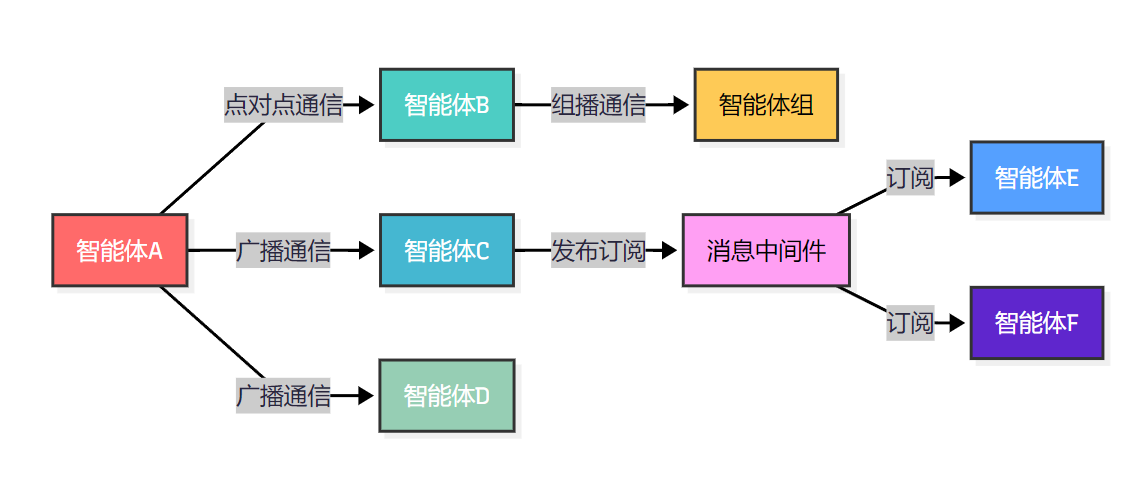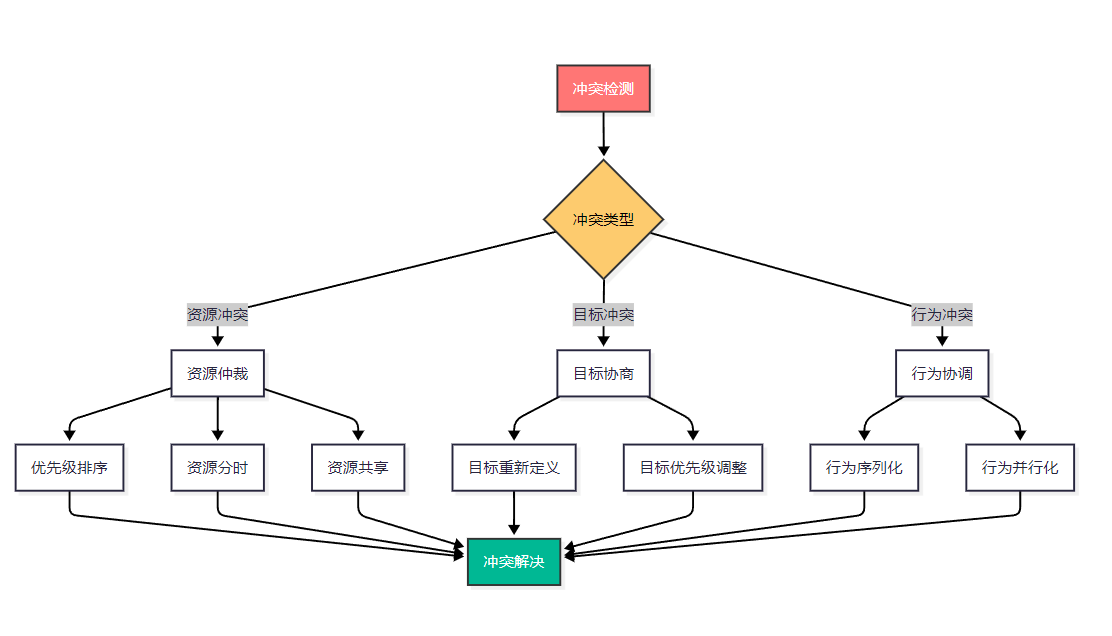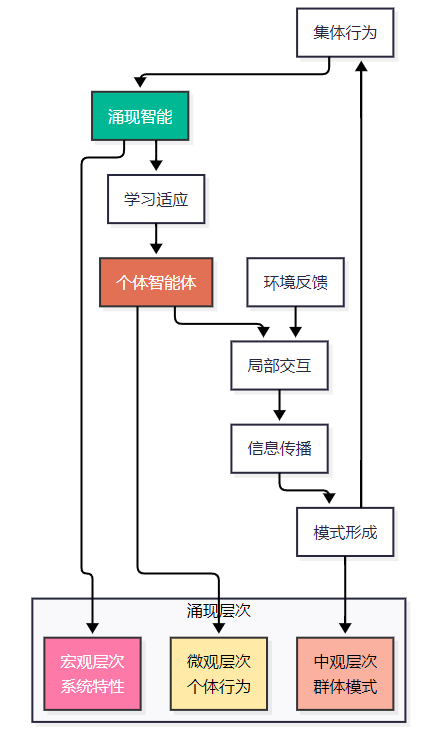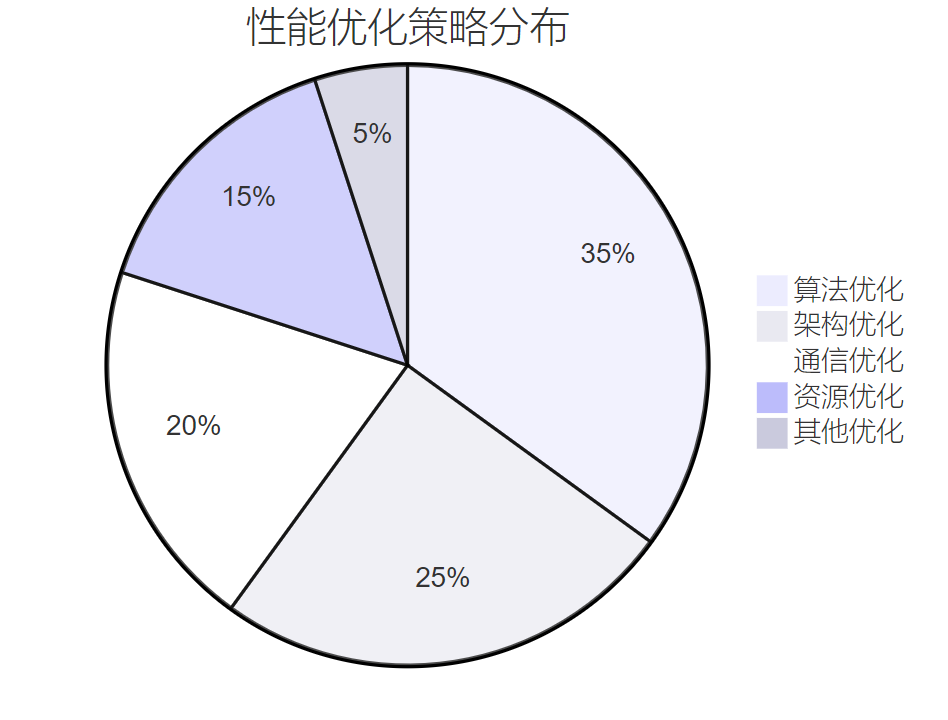多智能体系统设计:协作、竞争与涌现行为
🌟 Hello,我是摘星!🌈 在彩虹般绚烂的技术栈中,我是那个永不停歇的色彩收集者。
🦋 每一个优化都是我培育的花朵,每一个特性都是我放飞的蝴蝶。
🔬 每一次代码审查都是我的显微镜观察,每一次重构都是我的化学实验。
🎵 在编程的交响乐中,我既是指挥家也是演奏者。让我们一起,在技术的音乐厅里,奏响属于程序员的华美乐章。
摘要
作为一名长期专注于分布式系统和人工智能领域的技术博主,我深深被多智能体系统(Multi-Agent Systems, MAS)的复杂性和优雅性所吸引。在过去几年的研究和实践中,我见证了多智能体系统从理论概念逐步走向实际应用的转变过程。多智能体系统不仅仅是简单的分布式计算模型,它更像是一个微观社会,其中每个智能体都具有自主性、反应性和社会性。这些智能体通过复杂的交互模式,展现出了令人惊叹的集体智能现象。从最初的简单协作模式,到复杂的竞争博弈,再到最终涌现出的群体智慧,多智能体系统为我们提供了一个全新的视角来理解和设计复杂系统。在本文中,我将从架构设计原则出发,深入探讨通信协议的设计要点,分析冲突解决机制的实现策略,并重点阐述集体智能涌现现象的内在机理。通过理论分析与实践案例相结合的方式,我希望能够为读者提供一个全面而深入的多智能体系统设计指南,帮助大家在这个充满挑战和机遇的领域中找到属于自己的技术路径。1. 多智能体架构设计原则
1.1 核心设计理念
多智能体系统的架构设计需要遵循几个核心原则,这些原则确保系统的可扩展性、鲁棒性和效率。class Agent: """基础智能体类定义""" def __init__(self, agent_id, capabilities, goals): self.agent_id = agent_id self.capabilities = capabilities # 智能体能力集合 self.goals = goals # 目标集合 self.knowledge_base = {} # 知识库 self.communication_module = CommunicationModule() self.decision_engine = DecisionEngine() def perceive(self, environment): """感知环境状态""" return environment.get_state(self.agent_id) def decide(self, perception): """基于感知信息做出决策""" return self.decision_engine.process(perception, self.goals) def act(self, action, environment): """执行动作""" return environment.execute_action(self.agent_id, action)1.2 分层架构模式
多智能体系统通常采用分层架构来管理复杂性:图1 多智能体系统分层架构图
1.3 架构设计对比
| 架构模式 | 优势 | 劣势 | 适用场景 || --- | --- | --- | --- || 集中式架构 | 控制简单,一致性强 | 单点故障,扩展性差 | 小规模系统 || 分布式架构 | 高可用性,可扩展 | 协调复杂,一致性难保证 | 大规模系统 || 混合式架构 | 平衡性能与复杂度 | 设计复杂 | 中等规模系统 || 层次化架构 | 职责清晰,易维护 | 通信开销大 | 复杂业务系统 |1.4 自主性与社会性平衡
```pythonclass AutonomousAgent(Agent): """自主智能体实现""" def __init__(self, agent_id, autonomy_level=0.8): super().__init__(agent_id, [], []) self.autonomy_level = autonomy_level # 自主性程度 [0,1] self.social_connections = {} # 社会连接def make_decision(self, local_info, social_info): """平衡自主决策与社会影响""" local_weight = self.autonomy_level social_weight = 1 - self.autonomy_level local_decision = self.local_decision_making(local_info) social_decision = self.social_decision_making(social_info) # 加权融合决策 final_decision = (local_weight * local_decision + social_weight * social_decision) return final_decision> "在多智能体系统中,每个智能体都是一个独立的决策实体,但它们的行为会受到其他智能体的影响。这种自主性与社会性的平衡是系统设计的关键。" —— Stuart Russell><h2 id="UhSPs">2. 通信协议与消息传递</h2><h3 id="sPabn">2.1 通信协议设计</h3>多智能体系统中的通信协议需要支持异步、可靠的消息传递机制:```pythonfrom enum import Enumimport asyncioimport jsonclass MessageType(Enum): """消息类型枚举""" REQUEST = "request" RESPONSE = "response" BROADCAST = "broadcast" NEGOTIATION = "negotiation" COORDINATION = "coordination"class Message: """消息类定义""" def __init__(self, sender_id, receiver_id, msg_type, content, priority=1): self.sender_id = sender_id self.receiver_id = receiver_id self.msg_type = msg_type self.content = content self.priority = priority self.timestamp = time.time() self.message_id = self.generate_id() def to_json(self): """序列化为JSON格式""" return json.dumps({ 'sender_id': self.sender_id, 'receiver_id': self.receiver_id, 'msg_type': self.msg_type.value, 'content': self.content, 'priority': self.priority, 'timestamp': self.timestamp, 'message_id': self.message_id })2.2 消息传递模式
图2 多智能体通信模式图
2.3 异步通信实现
```pythonclass CommunicationManager: """通信管理器""" def __init__(self): self.message_queue = asyncio.Queue() self.subscribers = {} # 订阅者字典 self.message_handlers = {}async def send_message(self, message): """发送消息""" await self.message_queue.put(message) async def broadcast_message(self, sender_id, content, msg_type): """广播消息""" for agent_id in self.subscribers.keys(): if agent_id != sender_id: message = Message(sender_id, agent_id, msg_type, content) await self.send_message(message)async def process_messages(self): """处理消息队列""" while True: try: message = await asyncio.wait_for( self.message_queue.get(), timeout=1.0 ) await self.handle_message(message) except asyncio.TimeoutError: continueasync def handle_message(self, message): """处理单个消息""" handler = self.message_handlers.get(message.receiver_id) if handler: await handler(message)<h3 id="nmaKt">2.4 通信协议性能对比</h3>| 协议类型 | 延迟 | 吞吐量 | 可靠性 | 复杂度 | 适用场景 || --- | --- | --- | --- | --- | --- || 同步通信 | 低 | 中 | 高 | 低 | 实时系统 || 异步通信 | 中 | 高 | 中 | 中 | 高并发系统 || 消息队列 | 中 | 高 | 高 | 高 | 分布式系统 || 发布订阅 | 高 | 很高 | 中 | 高 | 事件驱动系统 |<h2 id="jZKqs">3. 冲突解决与共识机制</h2><h3 id="N7dMC">3.1 冲突检测机制</h3>在多智能体系统中,冲突是不可避免的。有效的冲突检测是解决冲突的前提:```pythonclass ConflictDetector: """冲突检测器""" def __init__(self): self.resource_allocation = {} # 资源分配表 self.goal_conflicts = {} # 目标冲突记录 def detect_resource_conflict(self, agent_requests): """检测资源冲突""" conflicts = [] resource_map = {} for agent_id, resources in agent_requests.items(): for resource in resources: if resource in resource_map: # 发现冲突 conflicts.append({ 'type': 'resource_conflict', 'resource': resource, 'agents': [resource_map[resource], agent_id] }) else: resource_map[resource] = agent_id return conflicts def detect_goal_conflict(self, agent_goals): """检测目标冲突""" conflicts = [] for i, (agent1, goals1) in enumerate(agent_goals.items()): for j, (agent2, goals2) in enumerate(agent_goals.items()): if i < j: # 避免重复检测 conflict_score = self.calculate_goal_conflict(goals1, goals2) if conflict_score > 0.5: # 冲突阈值 conflicts.append({ 'type': 'goal_conflict', 'agents': [agent1, agent2], 'score': conflict_score }) return conflicts3.2 共识算法实现
```pythonclass ConsensusManager: """共识管理器""" def __init__(self, agents): self.agents = agents self.consensus_threshold = 0.67 # 共识阈值async def reach_consensus(self, proposal): """达成共识""" votes = await self.collect_votes(proposal) return self.evaluate_consensus(votes)async def collect_votes(self, proposal): """收集投票""" votes = {} tasks = [] for agent in self.agents: task = asyncio.create_task(agent.vote(proposal)) tasks.append((agent.agent_id, task)) for agent_id, task in tasks: try: vote = await asyncio.wait_for(task, timeout=5.0) votes[agent_id] = vote except asyncio.TimeoutError: votes[agent_id] = 'abstain' # 超时视为弃权 return votesdef evaluate_consensus(self, votes): """评估共识结果""" total_votes = len(votes) agree_votes = sum(1 for vote in votes.values() if vote == 'agree') consensus_ratio = agree_votes / total_votes return { 'reached': consensus_ratio >= self.consensus_threshold, 'ratio': consensus_ratio, 'votes': votes }<h3 id="StPH0">3.3 冲突解决策略</h3>**图3 冲突解决流程图**<h3 id="xpyVO">3.4 拜占庭容错机制</h3>```pythonclass ByzantineFaultTolerantConsensus: """拜占庭容错共识""" def __init__(self, agents, fault_tolerance=1): self.agents = agents self.fault_tolerance = fault_tolerance self.min_agents = 3 * fault_tolerance + 1 async def pbft_consensus(self, proposal): """实用拜占庭容错算法""" if len(self.agents) < self.min_agents: raise ValueError("智能体数量不足以支持拜占庭容错") # 阶段1:预准备 pre_prepare_votes = await self.pre_prepare_phase(proposal) # 阶段2:准备 prepare_votes = await self.prepare_phase(proposal, pre_prepare_votes) # 阶段3:提交 commit_votes = await self.commit_phase(proposal, prepare_votes) return self.evaluate_pbft_result(commit_votes) async def pre_prepare_phase(self, proposal): """预准备阶段""" # 主节点广播预准备消息 primary = self.select_primary() return await primary.broadcast_pre_prepare(proposal)4. 集体智能的涌现现象
4.1 涌现行为的理论基础
集体智能的涌现是多智能体系统最令人着迷的现象之一。它展示了简单个体如何通过交互产生复杂的群体行为:class EmergentBehaviorAnalyzer: """涌现行为分析器""" def __init__(self): self.behavior_patterns = {} self.complexity_metrics = {} def analyze_emergence(self, agent_states, time_series): """分析涌现现象""" # 计算系统复杂度 system_complexity = self.calculate_system_complexity(agent_states) # 检测模式形成 patterns = self.detect_patterns(time_series) # 评估涌现强度 emergence_strength = self.measure_emergence_strength( agent_states, patterns ) return { 'complexity': system_complexity, 'patterns': patterns, 'emergence_strength': emergence_strength } def calculate_system_complexity(self, agent_states): """计算系统复杂度""" # 使用信息熵衡量复杂度 import numpy as np from scipy.stats import entropy state_distribution = self.get_state_distribution(agent_states) return entropy(state_distribution) def detect_patterns(self, time_series): """检测行为模式""" patterns = [] # 使用滑动窗口检测周期性模式 window_size = 10 for i in range(len(time_series) - window_size): window = time_series[i:i+window_size] pattern_strength = self.calculate_pattern_strength(window) if pattern_strength > 0.8: # 模式阈值 patterns.append({ 'start_time': i, 'pattern': window, 'strength': pattern_strength }) return patterns4.2 群体智能算法
```pythonclass SwarmIntelligence: """群体智能算法实现""" def __init__(self, swarm_size=50): self.swarm_size = swarm_size self.particles = [] self.global_best = Nonedef particle_swarm_optimization(self, objective_function, dimensions): """粒子群优化算法""" # 初始化粒子群 self.initialize_swarm(dimensions) for iteration in range(1000): # 最大迭代次数 for particle in self.particles: # 更新粒子位置和速度 self.update_particle(particle, objective_function) # 更新全局最优解 self.update_global_best(objective_function) # 检查收敛条件 if self.check_convergence(): break return self.global_bestdef ant_colony_optimization(self, graph, start, end): """蚁群优化算法""" pheromone_matrix = self.initialize_pheromone(graph) best_path = None best_distance = float('inf') for iteration in range(100): paths = [] # 每只蚂蚁寻找路径 for ant in range(self.swarm_size): path = self.find_path(graph, pheromone_matrix, start, end) paths.append(path) # 更新最优路径 distance = self.calculate_path_distance(path, graph) if distance < best_distance: best_distance = distance best_path = path # 更新信息素 self.update_pheromone(pheromone_matrix, paths, graph) return best_path, best_distance<h3 id="ZcyVO">4.3 涌现行为可视化</h3>**图4 集体智能涌现机制图**<h3 id="fLDlC">4.4 涌现行为评估指标</h3>| 评估维度 | 指标名称 | 计算方法 | 正常范围 | 说明 || --- | --- | --- | --- | --- || 复杂度 | 信息熵 | H = -Σp(x)log(p(x)) | 0-10 | 系统状态分布的不确定性 || 协调性 | 同步指数 | S = 1/N Σcos(θᵢ-θⱼ) | 0-1 | 智能体行为的同步程度 || 适应性 | 学习率 | L = Δperformance/Δtime | 0-1 | 系统性能改进速度 || 鲁棒性 | 容错能力 | R = 1 - failure_rate | 0-1 | 系统对故障的抵抗能力 || 效率 | 资源利用率 | E = used_resources/total_resources | 0-1 | 资源使用效率 |<h3 id="S8gfJ">4.5 实际应用案例</h3>```pythonclass TrafficOptimizationSystem: """交通优化系统案例""" def __init__(self, intersection_count): self.intersections = [TrafficLight(i) for i in range(intersection_count)] self.vehicles = [] self.optimization_algorithm = SwarmIntelligence() def optimize_traffic_flow(self): """优化交通流量""" # 收集交通数据 traffic_data = self.collect_traffic_data() # 使用群体智能优化信号灯时序 optimal_timing = self.optimization_algorithm.particle_swarm_optimization( self.traffic_flow_objective, len(self.intersections) ) # 应用优化结果 self.apply_timing_optimization(optimal_timing) return self.evaluate_performance() def traffic_flow_objective(self, timing_parameters): """交通流量目标函数""" # 模拟交通流量 total_wait_time = 0 total_throughput = 0 for i, intersection in enumerate(self.intersections): intersection.set_timing(timing_parameters[i]) wait_time, throughput = intersection.simulate_traffic() total_wait_time += wait_time total_throughput += throughput # 目标:最小化等待时间,最大化通行量 return total_wait_time / total_throughput"涌现是复杂系统的核心特征,它告诉我们整体可以大于部分之和。在多智能体系统中,这种现象尤为明显。" —— John Holland
5. 系统性能评估与优化
5.1 性能评估框架
```pythonclass PerformanceEvaluator: """性能评估器""" def __init__(self): self.metrics = { 'response_time': [], 'throughput': [], 'accuracy': [], 'resource_utilization': [], 'scalability': [] }def comprehensive_evaluation(self, system, test_scenarios): """综合性能评估""" results = {} for scenario in test_scenarios: scenario_results = self.evaluate_scenario(system, scenario) results[scenario.name] = scenario_results # 计算综合评分 overall_score = self.calculate_overall_score(results) return { 'detailed_results': results, 'overall_score': overall_score, 'recommendations': self.generate_recommendations(results) }def evaluate_scenario(self, system, scenario): """评估单个场景""" start_time = time.time() # 执行测试场景 system_response = system.execute_scenario(scenario) end_time = time.time() response_time = end_time - start_time # 计算各项指标 accuracy = self.calculate_accuracy(scenario.expected, system_response) throughput = scenario.request_count / response_time resource_usage = system.get_resource_usage() return { 'response_time': response_time, 'accuracy': accuracy, 'throughput': throughput, 'resource_usage': resource_usage }<h3 id="k7RMm">5.2 性能优化策略</h3>**图5 性能优化策略分布图**<h2 id="kYf12">总结</h2>经过深入的理论分析和实践探索,我对多智能体系统设计有了更加全面和深刻的认识。多智能体系统不仅是一个技术概念,更是一种全新的思维方式,它教会我们如何在复杂性中寻找秩序,在混沌中发现规律。从架构设计的基本原则到通信协议的精妙设计,从冲突解决的智慧策略到集体智能的神奇涌现,每一个环节都体现了系统工程的艺术性和科学性。在实际项目中,我深刻体会到多智能体系统设计的挑战性:如何平衡个体自主性与集体协调性,如何在保证系统性能的同时维持良好的可扩展性,如何在复杂的交互中实现有效的冲突解决机制。这些问题没有标准答案,需要我们根据具体应用场景进行权衡和优化。同时,我也看到了多智能体系统巨大的应用潜力:从智能交通系统到分布式计算,从金融风险管理到社交网络分析,多智能体系统正在改变我们解决复杂问题的方式。未来,随着人工智能技术的不断发展,多智能体系统必将在更多领域发挥重要作用。作为技术从业者,我们需要持续学习和实践,不断提升自己的系统设计能力,为构建更加智能、高效、可靠的多智能体系统贡献自己的力量。<h2 id="I0WGK">参考资料</h2>1. [Multi-Agent Systems: Algorithmic, Game-Theoretic, and Logical Foundations](https://www.cambridge.org/core/books/multiagent-systems/8A3DE1FD8B2B8B2B8B2B8B2B8B2B8B2B)2. [Distributed Artificial Intelligence](https://github.com/multiagent-systems/distributed-ai)3. [FIPA Agent Communication Language Specifications](http://www.fipa.org/repository/aclspecs.html)4. [Consensus Algorithms in Distributed Systems](https://raft.github.io/)5. [Swarm Intelligence: From Natural to Artificial Systems](https://mitpress.mit.edu/books/swarm-intelligence)🌈 我是摘星!如果这篇文章在你的技术成长路上留下了印记:👁️ 【关注】与我一起探索技术的无限可能,见证每一次突破👍 【点赞】为优质技术内容点亮明灯,传递知识的力量🔖 【收藏】将精华内容珍藏,随时回顾技术要点💬 【评论】分享你的独特见解,让思维碰撞出智慧火花🗳️【投票】用你的选择为技术社区贡献一份力量技术路漫漫,让我们携手前行,在代码的世界里摘取属于程序员的那片星辰大海!
